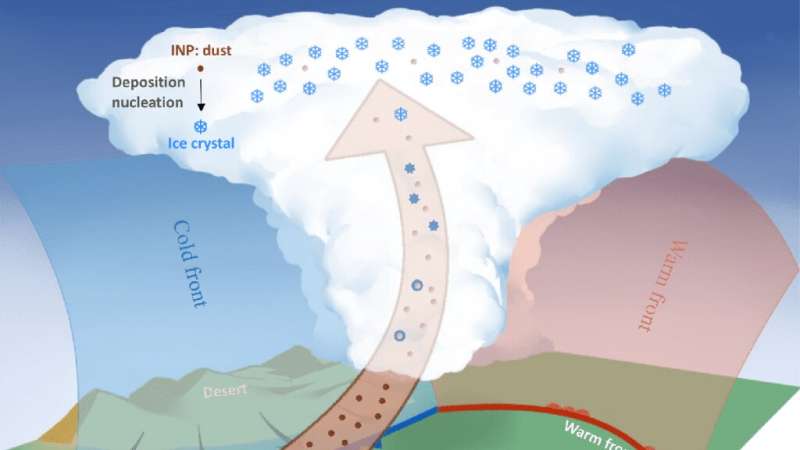
Cirrus clouds are high-altitude (8–17 kilometers) clouds composed of pure ice particles. These clouds have a significant impact on the planet’s climate by scattering incoming sunlight and absorbing Earth’s emitted infrared radiation. In a new study, Zeng et al. discovered new details about how these wispy, hair-like clouds form in large storm systems.
Ice forms cirrus clouds in two ways. In homogeneous nucleation, drops of liquid water spontaneously freeze when they encounter the appropriate conditions. In heterogeneous nucleation, a secondary particle, such as a mote of dust, provides a site around which the ice crystal forms. The heterogeneous pathway operates in a wider range of conditions, but it requires the presence of adequate debris.
In the past, researchers thought that ice crystals in cirrus clouds formed mostly through homogeneous nucleation because of low temperatures and the lack of ice-nucleating particles at high altitudes. In the new study, the scientists suggest that under the right conditions, heterogeneous nucleation may play a larger role than previously appreciated.
The researchers tested the role that strong storms called dust-infused barocline storm systems (DIBS) play in cirrus cloud formation. These storms lift dust particles from Earth’s surface into the atmosphere through warm conveyor belts. Prior research using satellite data revealed that cloud tops of DIBS have unusual, cirrus-like properties. In the new study, the scientists used satellite data and modeling to show that extremely high ice crystal concentrations in DIBS cirrus are formed through heterogeneous freezing.
The study drew on data from a May 2017 DIBS event in East Asia recorded by four separate weather satellites. The imaging, spectroscopic, radar, and lidar data indicated that the 2017 storm produced extremely high ice particle concentrations of 1 to 10 particles per cubic centimeter, with particle sizes in the range of 10 to 30 micrometers.
These data were used in a weather forecasting model (WRF-Chem). The authors ran the model in two configurations: one simple model that depended only on temperature and a second, more complex model that included additional factors like the surface area of nucleating particles.
The authors found that the more sophisticated parameterization matched cloud observations more closely than the simple model: The new, more complex model yielded ice particle concentrations that were 10 to 100 times higher and particle sizes that were 2 to 3 times smaller. These findings, the authors say, indicate that ice crystals in DIBS are formed through heterogeneous nucleation of dust particles.
The findings provide a mechanism of cirrus cloud formation in DIBS that the authors say should be incorporated into future climate models.
The study is published in the Journal of Geophysical Research: Atmospheres.
More information:
Yi Zeng et al, Extremely High Concentrations of Ice Particles in East Asian Dust‐Infused Baroclinic Storm (DIBS) Cirrus Shield: Dominant Role of Dust Ice Nucleation Effect, Journal of Geophysical Research: Atmospheres (2023). DOI: 10.1029/2022JD038034
Journal information:
Journal of Geophysical Research – Atmospheres
Provided by
Eos
This story is republished courtesy of Eos, hosted by the American Geophysical Union. Read the original story here.
Dust lifted into the air by cyclones provides anchor points for cloud-forming ice (2023, March 14)
retrieved 15 March 2023
from https://phys.org/news/2023-03-air-cyclones-anchor-cloud-forming-ice.html
part may be reproduced without the written permission. The content is provided for information purposes only.